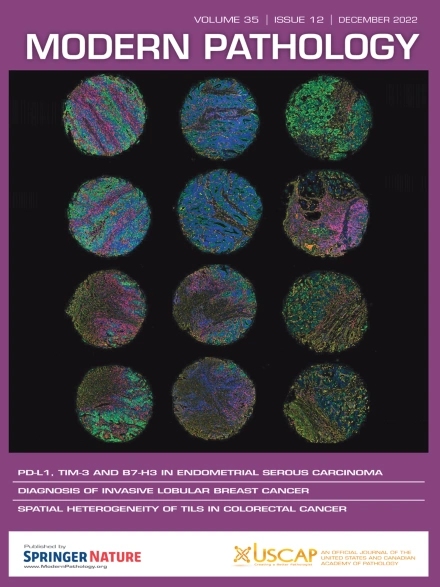唾液腺肿瘤的 DNA 甲基化分析支持并扩展了传统分类。
IF 5.5
1区 医学
Q1 PATHOLOGY
引用次数: 0
摘要
大唾液腺和小唾液腺肿瘤在组织学上包括多种多样且部分重叠的肿瘤,在诊断上经常具有挑战性。尽管最近在分子检测和肿瘤特异性突变或基因融合的鉴定方面取得了进展,但对于缺乏特异性改变的实体来说,鉴定其他诊断生物标志物的需求仍未得到满足。在这项研究中,我们收集了一个包含 20 种不同唾液腺肿瘤实体的 363 个病例的综合队列,并探索了 DNA 甲基化对这些肿瘤进行分类的潜力。我们能够证明大多数实体都显示出特定的表观遗传特征,并提出了一种机器学习算法,其平均平衡准确率达到了 0.991。值得注意的是,我们发现楔形腺癌在表观遗传学上有别于经典的多形性腺癌,这有助于对这些肿瘤进行风险分层。肌上皮瘤和多形性腺瘤形成了一个统一的表观遗传学类别,支持了具有广泛但连续形态谱的单一实体的理论。此外,我们还发现了一个组织形态异质但表观遗传学上不同的类别,它可能代表了一个新的肿瘤实体。总之,我们的研究提供了唾液腺肿瘤 DNA 甲基化图谱的全面资源。我们的数据提供了对有争议实体的新见解,并显示了 DNA 甲基化在识别新肿瘤类别方面的潜力。此外,我们的机器学习分类器将来还能支持涎腺肿瘤的组织病理学诊断。本文章由计算机程序翻译,如有差异,请以英文原文为准。
DNA Methylation Profiling of Salivary Gland Tumors Supports and Expands Conventional Classification
Tumors of the major and minor salivary glands histologically encompass a diverse and partly overlapping spectrum of frequent diagnostically challenging neoplasms. Despite recent advances in molecular testing and the identification of tumor-specific mutations or gene fusions, there is an unmet need to identify additional diagnostic biomarkers for entities lacking specific alterations. In this study, we collected a comprehensive cohort of 363 cases encompassing 20 different salivary gland tumor entities and explored the potential of DNA methylation to classify these tumors. We were able to show that most entities show specific epigenetic signatures and present a machine learning algorithm that achieved a mean balanced accuracy of 0.991. Of note, we showed that cribriform adenocarcinoma is epigenetically distinct from classical polymorphous adenocarcinoma, which could support risk stratification of these tumors. Myoepithelioma and pleomorphic adenoma form a uniform epigenetic class, supporting the theory of a single entity with a broad but continuous morphologic spectrum. Furthermore, we identified a histomorphologically heterogeneous but epigenetically distinct class that could represent a novel tumor entity. In conclusion, our study provides a comprehensive resource of the DNA methylation landscape of salivary gland tumors. Our data provide novel insight into disputed entities and show the potential of DNA methylation to identify new tumor classes. Furthermore, in future, our machine learning classifier could support the histopathologic diagnosis of salivary gland tumors.
求助全文
通过发布文献求助,成功后即可免费获取论文全文。
去求助
来源期刊

Modern Pathology
医学-病理学
CiteScore
14.30
自引率
2.70%
发文量
174
审稿时长
18 days
期刊介绍:
Modern Pathology, an international journal under the ownership of The United States & Canadian Academy of Pathology (USCAP), serves as an authoritative platform for publishing top-tier clinical and translational research studies in pathology.
Original manuscripts are the primary focus of Modern Pathology, complemented by impactful editorials, reviews, and practice guidelines covering all facets of precision diagnostics in human pathology. The journal's scope includes advancements in molecular diagnostics and genomic classifications of diseases, breakthroughs in immune-oncology, computational science, applied bioinformatics, and digital pathology.
 求助内容:
求助内容: 应助结果提醒方式:
应助结果提醒方式:


